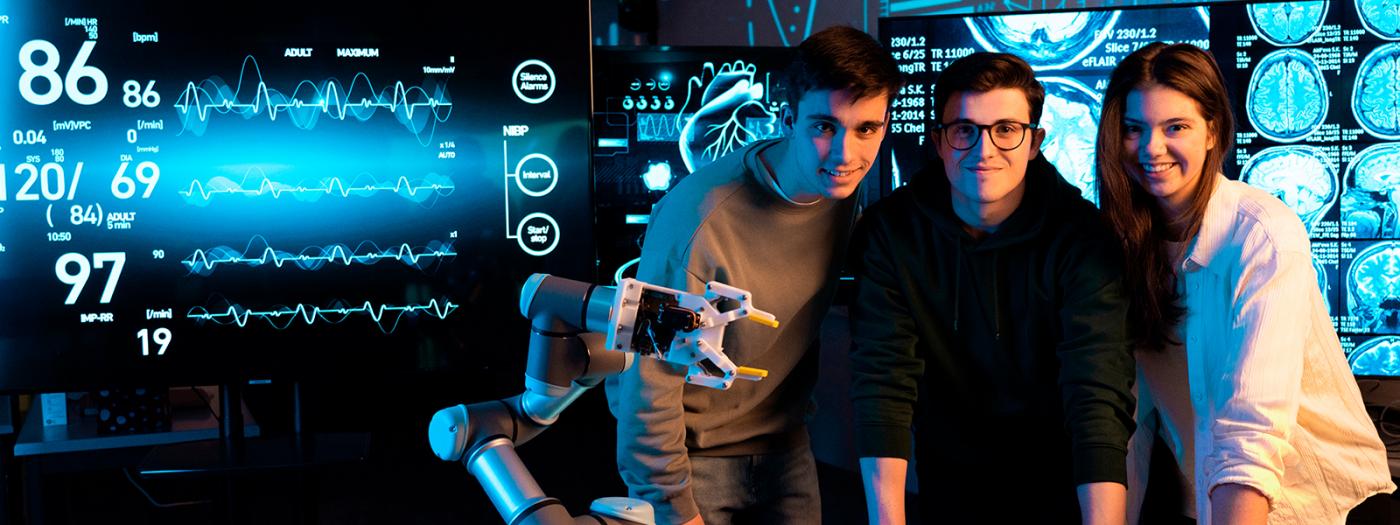The Biomechanics subject is based on the application of the fundamentals of physics to the anatomical structure of the human musculoskeletal system, assimilating the human body as a system of levers (bones and joints) to which force (muscles) is applied, generating its movement and thus facilitating its relationship with the environment. The composition and internal structure of the different materials (tissues) that make up the musculoskeletal system are also analyzed, subject to the action of internal (muscular) and external forces, to identify its normal mechanical behavior.
The teaching methodology and the choice of content provide students with learning outcomes aimed at carrying out preventive actions for pathologies related to the musculoskeletal system, as well as designing technical aids in those cases in which posture and movement may be altered.
Titular Professors
Not required
Learning Outcomes of this subject are:
- Interpret the main postural and locomotive bases of the human body based on the laws of mechanics
- Apply the concept of the torque of a force to the different joint axes of the locomotor apparatus and the functional human body with respect to the gravitational physical environment
- Identify the fundamental mechanical characteristics of the biological tissues of the human body and apply the principles of elasticity and deformation
- Understand the link between the mechanics of the injury and the preventive actions that engineering allows to prevent or minimize the risk factors
A. Functional biomechanics:
1) Human movement:
a) Strength. Production and transmission. Assessment and electromyography
b) Articular and functional torque
c) Neuromuscular and kinetic activity
2) Static biomechanics. Introduction to posture and analysis of standing, sitting and decubitus
3) Dynamic biomechanics. The gait. The grip
4) Injurious mechanisms. Alterations and pathomechanical risk factors in posture, locomotion, and functional action
B. Tissue biomechanics and repair mechanisms:
1) Connective tissue. bone tissue Cartilaginous tissue. Capsular-ligamentous and synovial tissue. tendinous tissue
2) Skeletal muscle tissue
3) Skin tissue
4) Nervous tissue
The methodology used is based on a model that combines theoretical-lecture classes, theoretical-practical classes and laboratory practices.
During the lecture sessions, students will receive explanations about the theoretical bases of the proposed contents and leave open the possibility of specific interactions with the aim of dispelling any doubts that students may have.
In the theoretical-practical classes, specific problems and exercises will be posed to reinforce the theoretical bases presented, thus understanding their applicability. These brief activities can only be carried out during face-to-face training with a teacher and in no case will they be announced in advance in the class itself.
Finally, the practical laboratory classes will be carried out in small groups and in them the functional action of human gait will be analyzed. A low-cost two-dimensional kinematic laboratory will be used (accessible resources such as a smartphone or a tape measure) and using free software (Kinovea), as well as a sophisticated three-dimensional capture system (Medialab with Vicon system) where kinematic data (Nexus) will be exported to be processed, analyzed and subsequently presented by the students.
The Biomechanics subject will be assessed by a continuous assessment system structured as follows:
Ordinary call / 1st call
Part I: continuous assessment (50%):
- Solving exercises or problems (20%)*
- Laboratory practices (20%)**
- Oral presentation (5%)*
- Class participation, attendance and readiness (5%)*
Part II: final assessment (50%):
- Final exam**
* Moderately significant assessment activity
** Highly significant assessment activity
In order to pass the subject, the result of the final exam must be equal to or greater than 4. Otherwise, the subject will be failed and the student will have to appear in the extraordinary call.
Non-presentation of the other activities will count as a 0 in the final grade.
Extraordinary call / 2nd call
All continuous assessment grades (passed or failed) will be maintained, so the second call will only consist of a final theoretical exam on the contents of the entire subject.
Neumann DA, Roen Kelly E, Kiefer C, Martens K, Grosz CM. Cinesiología del sistema musculoesquelético. 3ª ed. Padova: Editorial Panamericana-Piccin; 2022.
